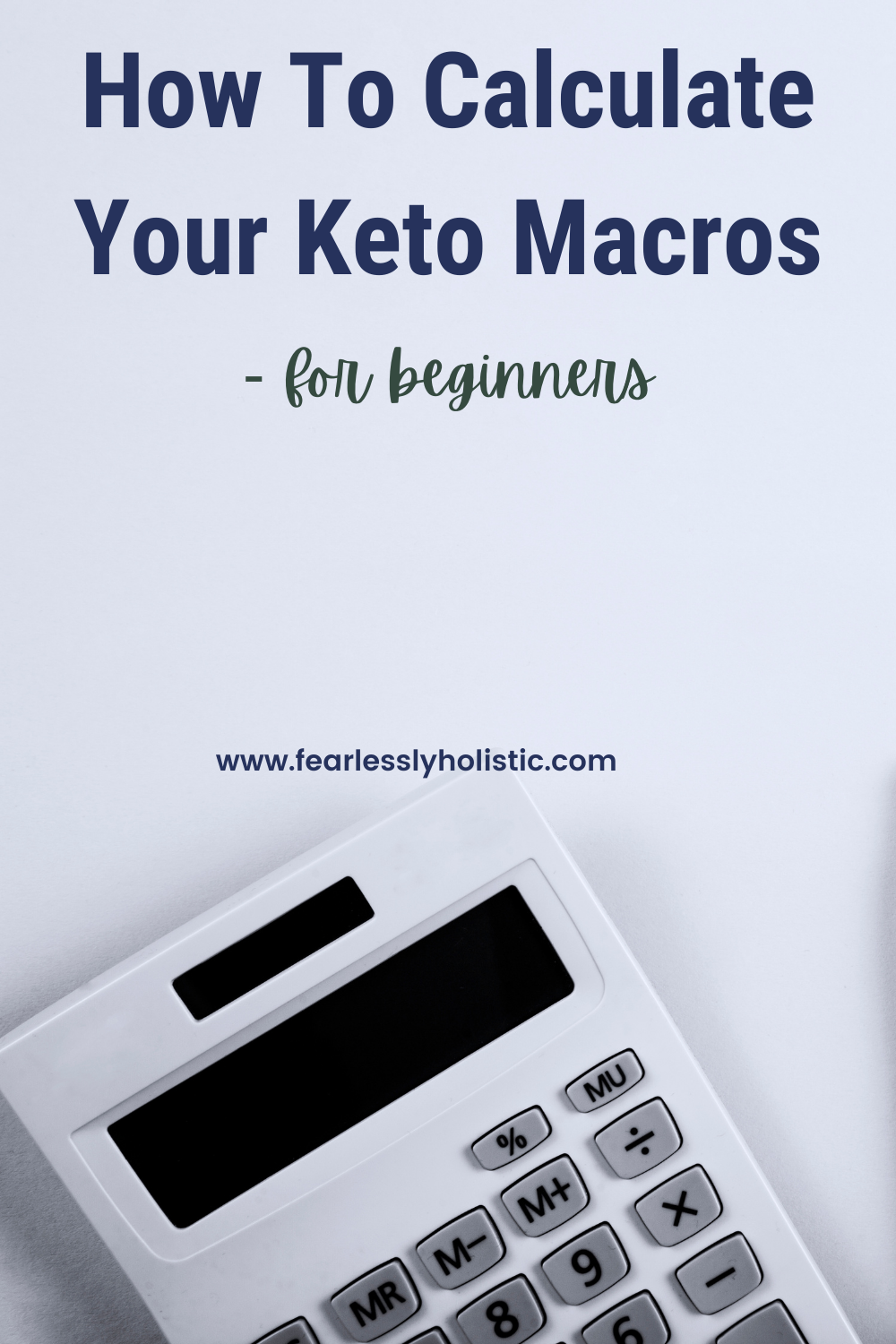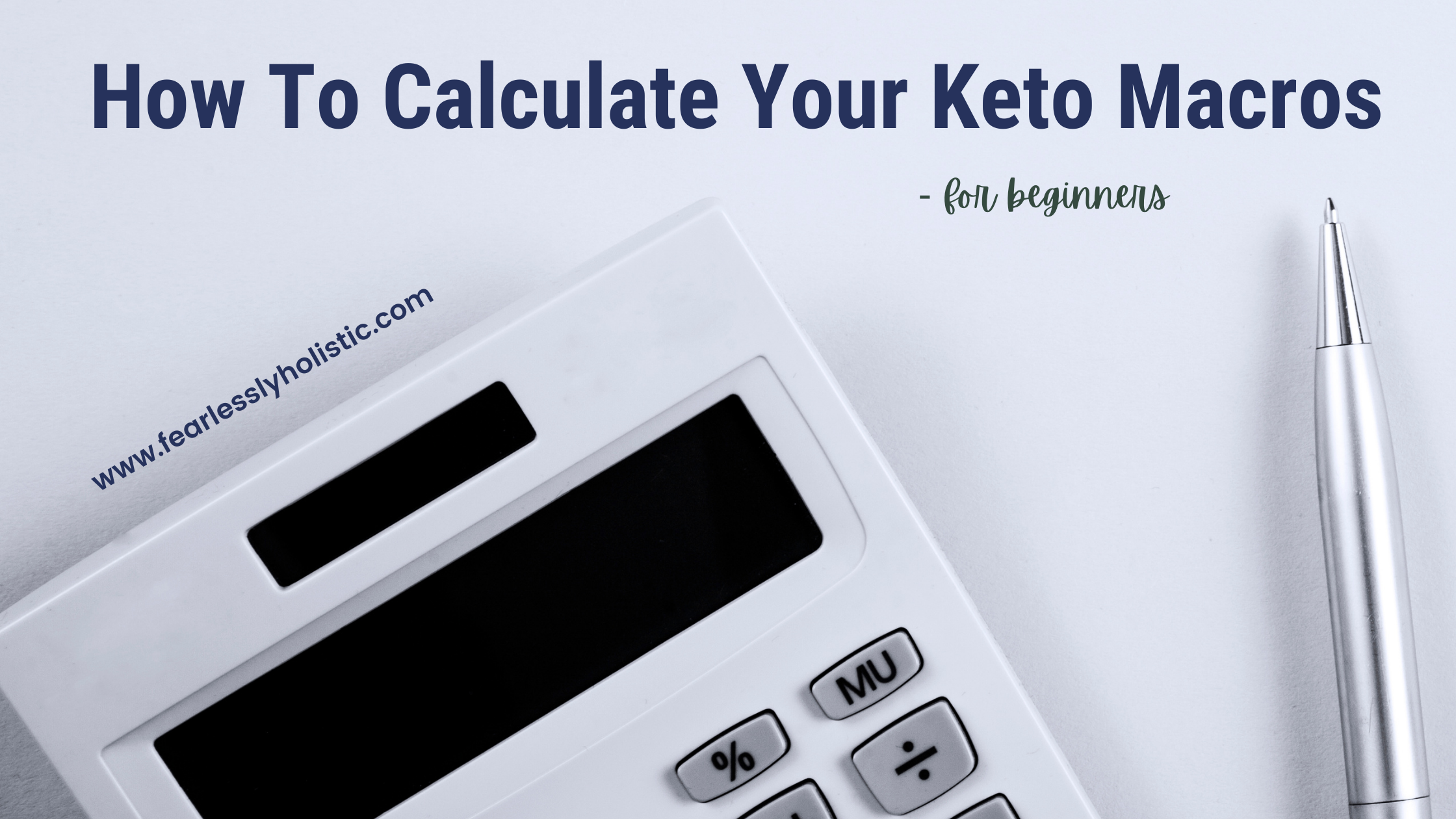Today is all about how to calculate your Keto macros. Macro-nutrients, or macros for short, are the 3 main categories of nutrients, and they are:
- Fat,
- Protein, and
- Carbohydrates.
Of the 3 macro-nutrients, only fat and protein contain “essential” nutrients for life and health. There are no essential carbohydrates, and today you find out why.
Hello and welcome to Fearlessly Holistic.
My name is Irma and I want to share my journey to improved health by eating whole foods, moving my body and eliminating stress as much as possible.
It is my hope to inspire you to make daily changes. Why? Because eating fresh, seasonal food, getting some sunshine, and purging unhelpful thinking is the best way to increase longevity. But you do not want just a long life.
You want a quality long life.
Ready to start Keto? Grab my Keto Food Guide and start eating better today. Keto diet, and especially clean keto which I advocate for, it healthy and delicious and nourishes your body. When you feed your body healthy food, it encourages healing and helps your body achieve a natural weight.
My blog posts are my opinion and the results of things that I have tried that either worked for me or didn’t. My opinions are for informational purposes only and are not intended as medical advice. Medical advice should always be obtained from a qualified medical professional for any health conditions or symptoms associated with them. As well, there may be affiliate links in this post. Read more here.
What Should Macros Be on a Keto Diet?
It is helpful for people changing their diet to figure out the correct ratio of food types to
- Satisfy your body’s nutritional requirements
- To improve health, if that is your goal. Typical goal improvements are: weight loss, better sleep, less joint/physical pain etc.
Most Keto dieters follow a plan that allows for these Keto macro percentages:
- 60-75% fat grams,
- 15-30% protein grams and
- 5-10% grams of carbs
according to the total number of calories consumed. I cannot tell you exactly what your macros would be, because it is based on your current weight, activity level, and goals.
It is recommended that you use a food tracking app to get your baseline macros, and work with those tweaking as you go. I recommend Cronometer (a free app), but you can use whichever one you like.
You may look at those Keto macro percentages and think “wow, that is a lot of fat”.
The good news is that it only ‘looks’ like that.
In reality, fat has twice the calories of the other macros so you do not have to eat much to hit your macros. As well, fat is in meat, dairy, and avocado’s so it is pretty easy to get enough on Keto.
Monitor your macros for the first two months
You will get really proficient at figuring out what works for your body, and what does not, by using a food tracker.
And a decent food tracker app will help you adjust your macros as you lose weight, so that you only eat the amount of food that you need. This helps to break unhealthy thought patterns around food.
One thing you need to know is that most people track their net carbs, not their total carbs.
Net carbs are when you take the total carbs and subtract the dietary fiber from it.
The fiber won’t negatively affect you, so it’s a non issue when calculating your macros to track.
This is a big deal on Keto diet, because “net carbs” are what are absorbed into your body.
For example, a large salad is going to have lots of fiber to deduct from the total number of carbs, because of the veggies.
After deducting the fiber, you can then use the extra carbs to splurge on items for your salad like berries, nuts, or a higher carb cheese cubes.
This can also be helpful for people who get to the end of their day and are feeling hungry. They may have enough carbs left in their macros to have a small bowl of fresh berries.
If you’re extremely athletic, then you might want to go on the higher end of the carb intake – the 30 grams, as opposed to 20.
But that’s only because your body needs more fuel, so if you’re sedentary, stick to the 20 grams instead. You will get results faster if you stay on the low end of your carb macros.
When you calculate the macro nutrients, you’ll want to think of the micro-nutrients that could impact your health, too.
These are the vitamins and minerals you need to ensure you get plenty of for your meals.
Whenever possible, purchase
- Fresh,
- Seasonal,
- Local and/or
- Organic
to get the best quality nutrients to feed your body. The closer it is to fresh picked, the more nutrients the produce contains.
Local/seasonal produce also tends to be cheaper. Fresh really is best!
Ensure you get the right nutrients by choosing the right carbohydrates for your diet.
Carbs are what your body uses for fuel first, and your body must burn them off before you can start burning your excess body fat (Ketosis).
Once you are in Ketosis, you will notice that you are hungry less often, so the Keto diet pairs really well with Intermittent Fasting.
You’d probably be shocked if you tallied up how many carbs you normally consume on a regular basis. And along with that, most processed carb foods contain a lot of unhealthy and unnatural ingredients.

Choose Leafy Greens as your Carbs
Leafy greens are nutritional powerhouses.
When our ancestors were hunter/gatherers, there was no grocery stores to provide strawberries in January. Winter was a time to eat meat, because that is what was available to pretty much any area of the world: meat, fish, fowl, seafood.
In spring, the earliest new edible vegetation are the leafy greens. They contain tons of different nutrients that energize your body to get outside and get things done…like finding more meat.
Meat is the Best Source of Protein for Hunter/Gatherers.
You only need enough protein to maintain muscle mass, but this also depends on your activity level. People who exercise a lot may require more protein for muscle repair.
Stay at the right macro levels that allow your body to have the necessary protein to grow and heal tissue in the body.
For me personally, too much meat stalls weight loss.
Conversely, if I want to increase the amount of fasting I am doing, I will eat several meat-heavy meals in a row.
When I am stuffed and do not feel the need to eat as often, I can put myself on a One Meal A Day (OMAD) protocol and do intermittent fasting quite easily.
I then get the benefits of Autophagy, which is the process of recycling dead or damaged cells, that would otherwise age me faster.
It is important to the Autophagy process to have at least 12 clear hours of fasting to trigger it.
If we eat 3 meals and day and 3 snacks, as suggested by food guidelines, Autophagy will not happen.
This is one reason for poor health in general. People’s body’s are clogged up with old cells, which make us look old before our time.
Quality Fats will help energize your body and use the vitamins you take in.
Healthy fats are building blocks of our cells, as well as feeding our brain the food it requires.
The worst thing the government food guidelines have done is to encourage people to:
- Remove healthy saturated fats from their diets
- Add in unhealthy trans-fats like soybean, canola, safflower, sunflower, corn, and other industrial seed oils, which do NOT feed our brains (because your body does not recognize these lab-made ingredients as food)
Industrial seed oils have a disgusting process in their creation – the use of solvents. I think I only had to read how they were made once to know that I do not want that stuff in my body.
Read about the process at Chris Kresser’s site.
Saturated fats on the other hand, contribute to improving health in multiple areas.
It will keep your hair and skin balanced and contribute to healthy cells.
And healthy fats have the added benefits of lowering the incidence of depression and other mental health issues, because the fat feeds your brain.
Avoid packaged trans fats or fast food and focus on fresh/healthy ones like those found in avocados, salmon, nuts and animal protein.
Conclusion
Eating clean food is a major part of holistic living, and Keto is a big part of that…if you are eating clean Keto, that is. I mean there is no point in trading one type of poor health for another.
Eat the best food that you can afford to give your body the building blocks it needs for optimal health, longevity, and looking good for as long as possible 😉
And do not forget about my FEARLESS KETO DIET KIT: get recipes, a shopping list, tips, and a planner to set goals, track progress, and success tips.
If you are not sure about the whole Keto diet thing, then just grab your copy of my Keto Food Guide by signing up below.
Holism targets overall wellness, and when we are well, we only get better with age.
Please share this post with anyone who can benefit from it. Sharing is caring!
And follow me on Pinterest!
Until next time, here’s to our health!
-Irma


